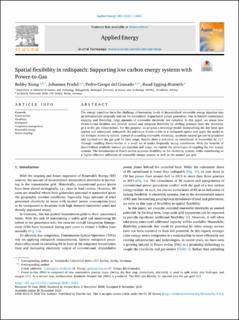| dc.contributor.author | Xiong, Bobby | |
| dc.contributor.author | Predel, Johannes | |
| dc.contributor.author | Egging-Bratseth, Ruud | |
| dc.contributor.author | Crespo del Granado, Pedro | |
| dc.date.accessioned | 2021-03-12T11:32:19Z | |
| dc.date.available | 2021-03-12T11:32:19Z | |
| dc.date.created | 2021-01-07T08:54:04Z | |
| dc.date.issued | 2020 | |
| dc.identifier.issn | 0306-2619 | |
| dc.identifier.uri | https://hdl.handle.net/11250/2733136 | |
| dc.description.abstract | The energy transition faces the challenge of increasing levels of decentralised renewable energy injection into an infrastructure originally laid out for centralised, dispatchable power generation. Due to limited transmission capacity and flexibility, large amounts of renewable electricity are curtailed. In this paper, we assess how Power-to-Gas facilities can provide spatial and temporal flexibility by shifting pressure from the electricity grid to the gas infrastructure. For this purpose, we propose a two-stage model incorporating the day-head spot market and subsequent redispatch. We introduce Power-to-Gas as a redispatch option and apply the model to the German electricity system. Instead of curtailing renewable electricity, synthetic natural gas can be produced and injected into the gas grid for later usage. Results show a reduction on curtailment of renewables by 12 % through installing Power-to-Gas at a small set of nodes frequently facing curtailment. With the benefits of decentralised synthetic natural gas injection and usage, we exploit the advantages of coupling the two energy systems. The introduction of Power-to-Gas provides flexibility to the electricity system, while contributing to a higher effective utilisation of renewable energy sources as well as the natural gas grid. | en_US |
| dc.language.iso | eng | en_US |
| dc.publisher | Elsevier | en_US |
| dc.rights | Navngivelse 4.0 Internasjonal | * |
| dc.rights.uri | http://creativecommons.org/licenses/by/4.0/deed.no | * |
| dc.title | Spatial flexibility in redispatch: Supporting low carbon energy systems with Power-to-Gas. | en_US |
| dc.type | Peer reviewed | en_US |
| dc.type | Journal article | en_US |
| dc.description.version | publishedVersion | en_US |
| dc.source.journal | Applied Energy | en_US |
| dc.identifier.doi | 10.1016/j.apenergy.2020.116201 | |
| dc.identifier.cristin | 1866732 | |
| dc.relation.project | EC/H2020/835896 | en_US |
| dc.relation.project | Norges forskningsråd: 296205 | en_US |
| cristin.ispublished | true | |
| cristin.fulltext | original | |
| cristin.qualitycode | 1 | |

